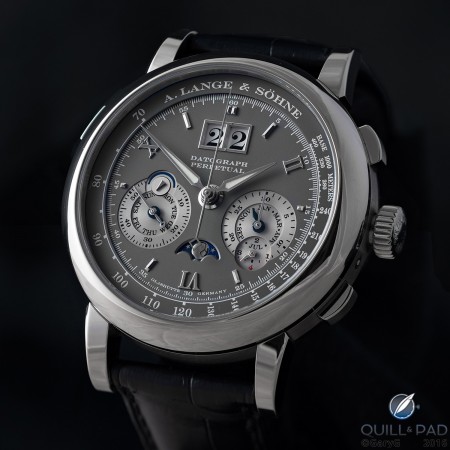
The design was also the foundation of the new Datograph Up/Down, which arrived only 2 years after. It was more modern per-se, alas in expense of losing its aggressive and definitive soul. Main updates were the baton indexes and a more slender font. In 2010, the brand introduced the Datograph Perpetual in pink gold ( 410.032). One strong example of this observation is Datograph Perpetual’s second generation. The brand started to ditch somewhat baroque designs and focused on more modern, minimal and streamline appearances. Within this period, Lange went through a transition in design.

Fabian Krone, then the CEO for 6 years left the company and Jeromé Lambert, now the CEO of Richemont, took over for a couple of years until the current CEO Wilhelm Schmid’s arrival. Lange & Söhne went through a management change in 2009. It was also the brand’s first use of white gold / grey dial combination which today is a signature coupledom.Ī. The white gold Datograph Perpetual, reference 410.030, on the other hand is aggressive, edgier and sportier. The platinum Datograph Perpetual, reference 410.025, is a bit more sober, understated and classy if you will with its heavier case, white dial that forms a better contrast with several details on the dial such as the Moon phase. Two of the first generation Datograph Perpetual watches offer almost completely different value.

I find such eccentric touch as a positive contribution to Datograph Perpetual’s already out of the box appearance – at least for the first generation. A friend calls them tumors which I find pretty harsh and disagree. Thus, my belief is that Lange probably wanted to continue on the same line, on a rather proven design. Both of these pieces pre-date the Datograph Perpetual and both feature hanging sub-dials.

Indeed, such non-optimal design is apparent in early A. Further the big date also limits the width of the Moon phase indication at 6 o’clock which leaves only so much place for this romantic complication.Īnother pet peeve for many enthusiasts is the day/night and leap year indications. The design suffers from legibility perspective compared to apertures (like Patek Philippe or Urban Jürgensen) solution. I must admit that such a design preserves the character just perfectly, alas has its own shortcomings.

The big date covers a rather wide area, so the only option for the day and month indications was to distribute them to their respective sub-dials. Of course, the brand’s signature perpetual calendar layout plays a big role here.Ī big part of the Datograph Perpetual’s character (and the brand’s in general) is formed by the big date, it had to stay there and this dictated the design choices for the calendar. Most importantly Datograph Perpetual masterfully safeguards the line’s character while managing to be recognizable on its own. As mentioned above, there’s a 2-mm difference in diameter between the non-perpetual calendar version and this addition is successfully distributed between the tachymeter scale and bezel. Since the Datograph Perpetual utilizes the same base as the Datograph’s L951.1, the placement of indications is exactly the same with its inspiration.


 0 kommentar(er)
0 kommentar(er)
